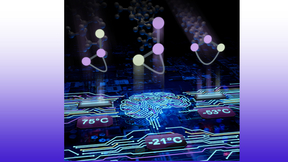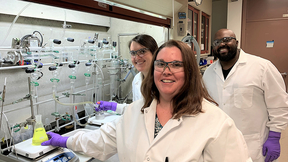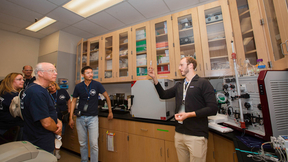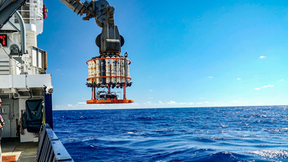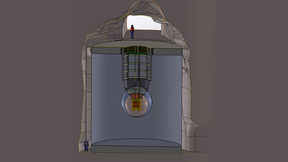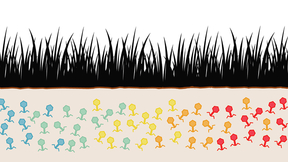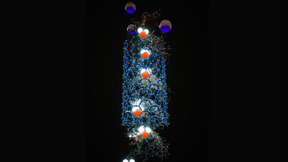Back
Around 2 million years ago, climate in Greenland resembled the forecast of a future under global warming: with trees such as poplars and birch and animals like hare, lemmings, mastodons and reindeer. Paleoclimatic records show strong polar amplification with annual temperatures of 11–19 degrees Celsius above current values. The biological communities inhabiting the Arctic…
X-ray diffraction measurements under laser-driven dynamic compression allow researchers to investigate the atomic structure of matter at hundreds of thousands of atmospheres of pressure and temperatures of thousands of degrees, with broad implications for condensed matter physics, planetary science and astronomy. Pressure determination in these experiments often relies on…
Lawrence Livermore scientists have performed a series of experiments through the National Ignition Facility’s (NIF’s) Discovery Science Program to replicate the extreme conditions within super-Earth cores and answered many questions posited by theoretical predictions and extrapolations from previously established relatively low pressure–temperature experimental data.
A team of Lawrence Livermore National Laboratory (LLNL) scientists has developed a new technique to analyze fentanyl in human blood and urine samples that could aid work in the fields of medicine and chemical forensics. Led by Carlos Valdez, an LLNL synthetic chemist and lead author, the team discussed its new fentanyl analysis approach in a paper recently published in the…
Hundreds of millions of tons of polymer materials are produced globally for use in a vast and ever-growing application space with new material demands such as green chemistry polymers, consumer packaging, adhesives, automotive components, fabrics and solar cells. But discovering suitable polymer materials for use in these applications lies in accurately predicting the…
Lawrence Livermore National Laboratory (LLNL) holds a quarterly Veterans Showcase to spotlight the work our veterans did while serving the nation and the work they continue to do in their Laboratory careers. The showcase held on November 9, 2022, highlighted the accomplishments of third-generation military veteran James Jones, who after joining the army at the age of 17,…
Linking the identity of wild microbes with their physiological traits and environmental functions is a key aim for environmental microbiologists. Of the techniques that strive for this goal, Stable Isotope Probing — SIP — is considered the most effective for studying active microorganisms in natural settings. Lawrence Livermore National Laboratory (LLNL) scientists have…
Under normal conditions, radioactive materials such as uranium work in a predictable manner. But take those same materials and put them under extreme conditions with high temperature in a short timescale and a rapid cooling process and their decomposition pathways change dramatically. Lawrence Livermore National Laboratory (LLNL) scientists built a unique process to…
Lawrence Livermore National Laboratory (LLNL) held an Employee Engagement Day to celebrate the institution’s 70th anniversary on October 11, 2022. For the event, the Physical and Life Sciences (PLS) directorate hosted a variety of tours and activities, providing a behind-the-scenes look into our multidisciplinary research efforts. The Biosciences and Biotechnology Division…
Satellite observations and computer simulations are important tools for understanding past changes in Earth’s climate and for projecting future changes. However, satellite observations consistently show less warming than climate model simulations from 1979 to the present, especially in the tropical troposphere (the lowest ~15km of Earth’s atmosphere). This difference has…
Lawrence Livermore National Laboratory (LLNL) and UC Santa Cruz scientists have detected a previously hypothesized class of nitrogen fixation in the surface ocean. Nitrogen scarcity limits the growth of ocean phytoplankton, a globally important carbon sink and the base of the marine food web. Nitrogen that can be used by phytoplankton generally has a very low concentration…
"Dwell fatigue" is a phenomenon that can occur in titanium alloys when held under stress, such as a jet engine's fan disc during takeoff. This peculiar failure mode can initiate microscopic cracks that drastically reduce a component's lifetime. The most widely used titanium alloy, Ti-6Al-4V, was not believed to exhibit dwell fatigue before the 2017 Air France Flight 066…
Immune responses could be supported by drugs to help people recover from brain infections caused by Rift Valley fever virus Research by Lawrence Livermore National Laboratory (LLNL) scientists suggests that immune responses could be bolstered by drugs to help people recover from brain infections caused by an emerging pathogen. The emerging pathogen studied by the team,…
Lawrence Livermore National Laboratory (LLNL) scientists Félicie Albert and Craig Siders have been selected as fellows of Optica (formerly OSA). Fellows are selected based on several factors, including distinguished contributions to education, research, engineering, business and serving the optics and photonics community. Click here to see the entire Optica 2023 class…
Lawrence Livermore National Laboratory (LLNL) has received $2.35 million from the Inflation Reduction Act, which aims to support domestic energy production and promote clean energy and to provide the Department of Energy (DOE) national laboratories with resources to keep the U.S. at the forefront of scientific discovery. The funding has been allocated for the Lab-led nEXO…
Soils contain diverse communities of microorganisms, including bacteria, fungi, protists and viruses. Interactions between these tiny organisms shape the ability of soils to store carbon underground. However, not much is known about the spatial patterns and dynamics of viral communities in soil. New research by Lawrence Livermore National Laboratory (LLNL) scientists and…
Transforming the way energy is collected, stored and used has become a defining challenge of the 21st century. To address this task, the Department of Energy’s (DOE) Office of Basic Energy Sciences (BES) established the Energy Frontier Research Center (EFRC) program. This year, Lawrence Livermore National Laboratory and collaborators were awarded three projects. The first…
A five-year microbial study of the International Space Station (ISS) and its astronauts by Lawrence Livermore National Laboratory (LLNL) and NASA researchers has found that the ISS habitat is safe for its residents. The research effort represents the first comprehensive characterization of the space station’s environmental profile (or microbiome) and is the first to…
Lawrence Livermore National Laboratory (LLNL) scientists are scaling up the production of vertically aligned single-walled carbon nanotubes (SWCNT) that could revolutionize diverse commercial products ranging from rechargeable batteries, automotive parts and sporting goods to boat hulls and water filters. The research appears in the journal Carbon. Most CNT production…
California native Kerianne Pruett started at LLNL in 2019 as an intern, and now works as a spacecraft systems engineer, matrixed to the Physics Division. At the Laboratory, Pruett utilizes data science, machine learning, and high-performance computing to answer questions about dark matter, dark energy, and space domain awareness.





